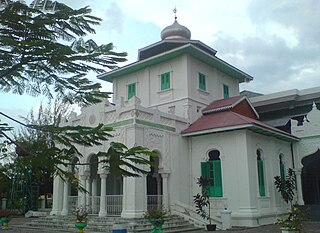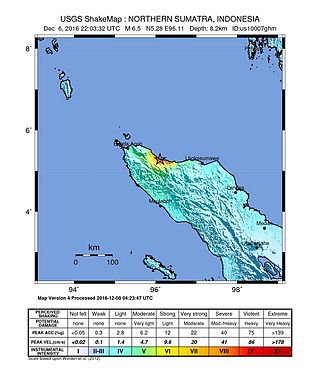
Sumatra is one of the Sunda Islands of western Indonesia. It is the largest island that is fully within Indonesian territory, as well as the sixth-largest island in the world at 482,286.55 km2 (182,812 mi.2), including adjacent islands such as the Simeulue, Nias, Mentawai, Enggano, Riau Islands, Bangka Belitung and Krakatoa archipelago.

Aceh, officially the Province of Aceh, is the westernmost province of Indonesia. It is located on the northern end of Sumatra island, with Banda Aceh being its capital and largest city. It is bordered by the Indian Ocean to the west, Strait of Malacca to the northeast, as well bordering the province of North Sumatra to the east, its sole land border, and shares maritime borders with Malaysia and Thailand to the east, and Andaman and Nicobar Islands of India to the north. Granted a special autonomous status, Aceh is a religiously conservative territory and the only Indonesian province practicing Sharia law officially. There are ten indigenous ethnic groups in this region, the largest being the Acehnese people, accounting for approximately 70% of the region's population of about 5.5 million people in mid-2023. Its area is comparable to Croatia or Togo.

Banda Aceh is the capital and largest city in the province of Aceh, Indonesia. It is located on the island of Sumatra and has an elevation of 35 meters. The city covers an area of 61.36 square kilometers (23.69 sq mi) and had a population of 223,446 people at the 2010 Census, rising to 252,899 at the 2020 Census. The official estimate as at mid 2023 was 261,969.

On 26 December 2004, at 07:58:53 local time (UTC+7), a major earthquake with a magnitude of 9.2–9.3 struck with an epicentre off the west coast of northern Sumatra, Indonesia. The undersea megathrust earthquake, known by the scientific community as the Sumatra–Andaman earthquake, was caused by a rupture along the fault between the Burma plate and the Indian plate, and reached a Mercalli intensity up to IX in some areas.

Indonesia was the first country to be seriously affected by the earthquake and tsunami created by the 2004 Indian Ocean earthquake on 26 December 2004, swamping the northern and western coastal areas of Sumatra, and the smaller outlying islands off Sumatra. Nearly all the casualties and damage took place within the province of Aceh. The time of arrival of the tsunami was between 15 and 30 minutes after the deadly earthquake. According to the country's National Disaster Relief Coordination Agency, around 130,000 people were dead and 37,063 were missing. In addition, the UN estimated that 655,000 people were homeless and sheltering in scattered refugee camps across the province.

Great Aceh Regency is a regency of the Indonesian province of Aceh. The regency covers an area of 2,903.49 square kilometres and had a population of 351,418 at the 2010 Census, 391,870 at the 2015 census and 405,535 at the 2020 Census; the official estimate as at mid 2023 was 435,298. The Regency is located at the northwest tip of Sumatra island and surrounds the provincial capital of Banda Aceh, many suburbs of which lie within the Regency. It also includes a number of islands off the northern tip of Sumatra, which comprise Pulo Aceh District within the regency. The seat of the Regency government is the town of Jantho.
The Indian Ocean Tsunami Warning System was set up to provide warning to inhabitants of nations bordering the Indian Ocean of approaching tsunamis. The tsunami warning system has been in use since the mid-2000s.

Library damage resulting from the 2004 Indian Ocean earthquake has been reported in six Asian countries. On December 26, the massive 2004 Indian Ocean earthquake struck off the northwest coast of the Indonesian island of Sumatra. The resulting tsunamis killed more than 180,000 people. In addition to the loss of human lives, cultural institutions were destroyed in several Asian nations. Libraries on the Eastern coast of Sri Lanka and the northern province of Aceh on Sumatra were most severely affected by the disaster.

The architecture of Indonesia reflects the diversity of cultural, historical, and geographic influences that have shaped Indonesia as a whole. Invaders, colonizers, missionaries, merchants, and traders brought cultural changes that had a profound effect on building styles and techniques.

Sultan Iskandar Muda International Airport (IATA: BTJ, ICAO: WITT) also called Banda Aceh Airport (Bandar Udara Banda Aceh), is an airport located 13.5 km (1.35×1013 nm; 8.4 mi) southeast of the capital of Aceh province, Banda Aceh. It is named after the twelfth sultan of Aceh, Iskandar Muda (1583–1636). This airport was formerly called Blangbintang Airport (Bandara Blangbintang), referred to its location in a district with same name. This airport is listed as the 23rd busiest airport in Indonesia.

Baiturrahman Grand Mosque is a mosque located in Banda Aceh, Aceh, Indonesia. The Baiturrahman Grand Mosque is a symbol of religion, culture, spirit, strength, struggle, and nationalism of the Acehnese people. The mosque is a landmark in Banda Aceh and has survived the 2004 Indian Ocean earthquake and tsunami.

The Aceh Tsunami Museum, located in Banda Aceh, Aceh, Indonesia, is a museum designed as a symbolic reminder of the 2004 Indian Ocean earthquake and tsunami disaster, as well as an educational center and an emergency disaster shelter in case the area is ever hit by a tsunami again.

Ulèë Lheuë is an area in Meuraxa sub-district, Banda Aceh, Indonesia. It was the former main seaport of Aceh. The town and seaport was heavily damaged and depopulated during the 2004 Indian Ocean earthquake and tsunami.

Teuku Mohammad Hasan was an Indonesian politician and national hero from Aceh, who served as the first and only governor of Sumatra from 1945 until 1948. He also served as a cabinet minister in Sjafruddin Prawiranegara's emergency cabinet and was a member of both the Senate of the United States of Indonesia (USI) and the Provisional People's Representative Council (DPRS) of the Republic of Indonesia.

The Ganting Grand Mosque is a Sunni mosque located in Ganting, Padang, West Sumatra, Indonesia. Construction began in 1805, making it the oldest in Padang and one of the oldest in Indonesia. It is a Cultural Property of Indonesia.

Aceh State Museum, popularly known as Aceh Museum or Banda Aceh Museum is a museum in Banda Aceh, Indonesia. It is one of the oldest museum in Indonesia.

The 2016 Aceh earthquake struck the Indonesian island of Sumatra with a Mw of 6.5 in Aceh province on 7 December 2016, at 05:03 WIB. The shock was reported to be at a depth of 13 km, categorized as a strong, shallow earthquake. The epicentre was located near the village of Reuleut in Pidie Jaya Regency, 164 km (102 mi) southeast of the province's capital, Banda Aceh. 104 people died in the quake, with at least 1,000 people injured. It was the deadliest earthquake in Aceh since the 2005 Nias–Simeulue earthquake and the deadliest in Sumatra since the 2010 Mentawai earthquake and tsunami.

Mosque architecture in Indonesia refers to the architectural traditions of mosques built in the archipelago of Indonesia. Initial forms of the mosque, for example, were predominantly built in the vernacular Indonesian architectural style mixed with Hindu, Buddhist or Chinese architectural elements, and notably didn't equip orthodox form of Islamic architectural elements such as dome and minaret. Vernacular architectural style varies depending on the island and region.
Building Back Better, or more frequently termed Build Back Better (BBB), is a strategy aimed at reducing the risk to the people of nations and communities in the wake of future disasters and shocks. It is a conceptual strategy that has continued to evolve since its origination in May 2005. However, what continues is the overall goal of enabling countries and communities to be stronger and more resilient following a disaster by reducing vulnerability to future disasters. Building resilience entails addressing physical, social, environmental, and economic vulnerabilities and shocks.

The Gouvernment of Atjeh and Dependencies was an administrative subdivision (governorate) of the Dutch East Indies located in northern Sumatra in the region of present-day Aceh, Indonesia which existed from the late nineteenth century to 1938. The capital of the governorate was at Koetaradja. In 1938, due to a reorganization of the government structure of the Indies, it no longer had a governor and became a Residency instead, called the Atjeh and Dependencies Residency.


































